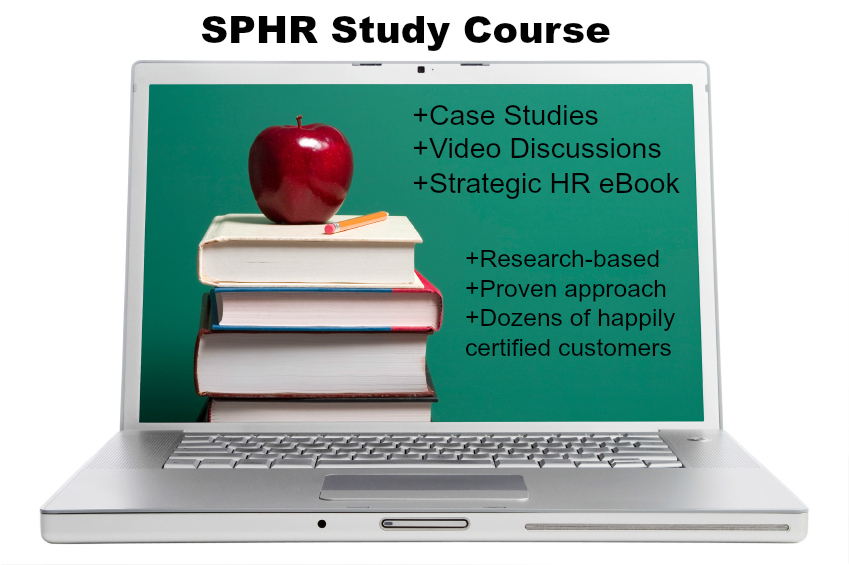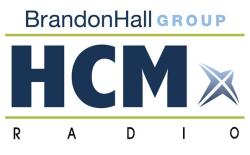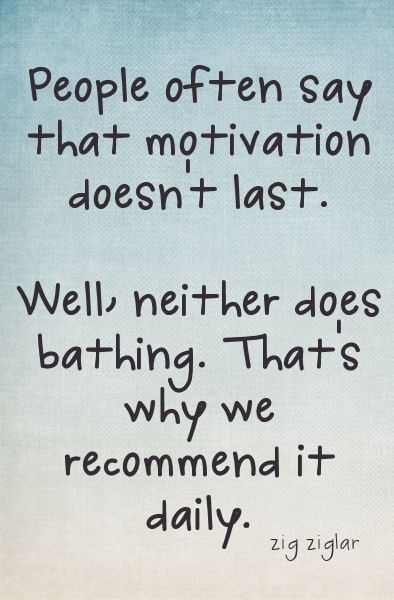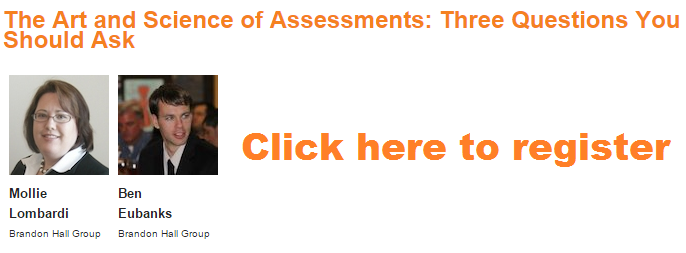I like giving advice based on experience, not opinion. When people previously asked me how to study for the SPHR exam, I’ve had to give them my opinion based on what I understood. To be honest, my response was pretty accurate, but it’s now nice to actually confirm that with my own completion of the SPHR certification. In case you missed it, I talked last week about my success in passing the SPHR exam, so I can now speak from experience in how to properly study. Today we’ll go over some of the best practices for SPHR study preparation as well as the launch of the new SPHR Study Course.
 Studying for the SPHR
Studying for the SPHR
I have collected some of the comments from people say about preparing for the exam. Some of them passed and some of them didn’t, but even a quick skim will show you some common themes:
Nicky
This weekend I took the Certification exam…..and didn’t pass. That was a bummer because I’ve been studying for so many months. I really appreciated your weekly emails and enjoyed your perspective that kept me engaged.
This exam reminded me EXACTLY of the SAT and GMAT – soooo abstract. I started the exam and by about question 15 was wondering if I was even taking the right test. Then I started to see a few things that looked familiar. I’ve attended school for many years and was expecting to be tested on text from the study manuals, similar to the practice tests you had provided, but that’s not what it looked like to me.
Instead this appeared to be….obscure sentences that I was really puzzled to figure out what the question was. I provided feedback at the end and indicated that I was really disappointed in the development of this exam. I didn’t think it tested my knowledge of the materials that I had studied. Sometimes I could eliminate two of the answers and then the two remaining answers were worded in such a way that I just guessed which one was right. How disappointing! I will not retake the exam because no amount of additional studying will prepare me to be successful for this type of examination. If I had not stumbled across your website, I would probably still be trying to figure out who administers the exam, who has the official study materials, etc.
So while this was an expensive overall endeavor, it brought me into the 21st century! I did feel like this whole experience really updated by HR knowledge. My undergraduate is in HR Management and my masters is in HR Development (Adult Education), but those were completed in the ’90s. I haven’t worked specifically in HR since 2000, but my HR background has come in handy in every job I’ve had. I’m currently a trainer and really hope to circle back to HR in the near future although many current job postings are specifically looking for the PHR/SPHR certification. It’s deflating to know that I’m eliminated from consideration because I don’t have the certification…..and 6 years of HR higher education takes a back seat :-)
Enough of my moaning and groaning. So, thanks for your advice, and I wish you continued success in your future endeavors. If I had my own business I’d trying to recruit you!
Jack
I took the PHR exam in 2010 and failed. I attended a university specifically to study for this exam; I had outlines and studied extensively and I agree with Mary, most of the test questions were so unfamiliar and panicked when I realized this was not covered in class and could not recall the information being on the outlines and notes I had. I had shown up to the test site confident as I had spent hours and hours studying and was very disappointed that I didn't succeed. I have been avoiding taking this test but will be signing up to take it again in December 2012. I hope to get a better test this time.
Mary
3 of us took the 2010 PHR today June 29, 2010 and June 28. Both the lady with 20 years HR experience and I said after the test –70 percent of the test was NOT even covered in the SHRM guides that cost $800 dollars. I passed she failed. She also did Ann B's book and HRCI. I did SHRM and HRCI. But almost nothing from those sources was on the test. I am not even happy about passing because it was just due to guess work not all the MONTHS of serious study I put in and she even put in more figuring out how to study for the SPHR exam. The questions are vague and the answers are nothing you read in your books, or nothing like your practice exams. Experience dosn't count because she had 20 years experience. The only way I passed was to put my HR knowledge aside and think like a business owner. At question 60 I wanted to go ask if they had loaded the right test.
Mariona
I was so mad, I didn’t pass and I had never studied so hard and felt to prepare, and I didn’t pass ( I went for SPHR)
Melissa
The rest of the group took it today. Very nervous because none of the group passed they said that the test was nothing like the practice test on the learning system.
Preparing for the SPHR
Can you tell me how to prepare for the SPHR exam?
Up until now you just had to pick out a study tool and try to guess how the SPHR content was different from the PHR content. In reality most of us don’t read deeply into the content and make connections with real world examples, so this is difficult to do. Up until today, there was no specific SPHR study tool on the market. I have launched my own SPHR Study Guide to meet that need. I’m excited about helping the next generation of SPHR test takers with the exam.
How long does it take to prepare for the SPHR?
It can take anywhere from several weeks to several months. It’s very dependent on your study habits, testing ability, experience level (depth), education level, and breadth of exposure to HR. For instance, a recruiter will have a harder time preparing than a generalist, because their work is not focused on a wide variety of HR practices.
Cramming for the SPHR exam
Can you tell me how to cram for the PHRÂ or SPHR exam?
I’d highly suggest that you not attempt to cram for the SPHR. There are just too many pieces of the body of knowledge that you aren’t exposed to every day (for example: visas, talent management planning, budgeting, managing risk, developing employee branding campaigns, etc.) I’d recommend taking time to do this over several weeks, and preferably several months. If you are stuck and have to “cram,” there’s one thing that will help you (assuming you have a basic HR knowledge foundation): take as many practice tests as you can get your hands on.
Public Service Announcement: Again, I will recommend that if you’re trying to figure out how to study for the SPHR exam, you should not cram.
Being “test smart” will go a long way toward helping you prepare, but if you don’t know the basic HR information than all the practice questions in the world won’t help you. This is not to teach you to memorize questions and answers, but more to seek out the “best” or “most likely” or “most efficient” answers by honing your judgment.
How to study for the SPHR exam: Sample SPHR study session
How should I study for the SPHR?
One of the things I started doing in the final weeks of preparation was to take a practice exam and copy the question/answers for anything that didn’t look familiar to me and paste it into a notepad. Then after the practice test I would Google each term to get a better understanding of the concepts I was weak in.
I’d also try to find an article or description of the idea in practice, when it would be used, and when it wouldn’t. That’s the key–knowing the term is only half the battle. Knowing how, when, and where to use it is the critical portion the SPHR tests on. Here’s a sample set of information after one of my practice runs. I’d research each term after the practice test or put it on my calendar to research during my next block of study time.
- Sample post test research, pre and post testing methods
- action teams vs task force vs others
- Product leadership, other strategies
- nominal technique vs delphi vs others
- union deauthorization/decert timelines
- balanced scorecard elements, uses, pros/cons
- scatter, histogram, gantt, pareto, other chart types and purposes
- leadership models
- http://en.wikipedia.org/wiki/Six_Sigma
- http://asq.org/learn-about-quality/total-quality-management/overview/deming-points.html
- quality initiatives
- http://en.wikipedia.org/wiki/PEST_analysis
- company growth stages and HR needs
- individual vs task vs organizational assessments
- bloom’s taxonomy, uses
- http://www.eeotraining.eeoc.gov/images/content/EXCELHandouts/2G%20Mock_Deposition_Practice.pdf
- compensable factors
- instructional design models
- http://www.mindtools.com/pages/article/kirkpatrick.htm
SPHR study course
 As I mentioned above, I am launching a new SPHR study course. This is a bonus module added to the standard SPHR/PHR Self Study Course that has helped dozens of students pass the exam over the past few years. I highly encourage you to check it out if you are planning to take the SPHR this year. The price is for the basic model and will be increasing as I add additional case studies, questions, and video discussions. More info here.
As I mentioned above, I am launching a new SPHR study course. This is a bonus module added to the standard SPHR/PHR Self Study Course that has helped dozens of students pass the exam over the past few years. I highly encourage you to check it out if you are planning to take the SPHR this year. The price is for the basic model and will be increasing as I add additional case studies, questions, and video discussions. More info here.
Other comments from SPHR candidates
I didn’t want to put all of these up front, because it is a pretty long summary. However, I think the comments are worthwhile and wanted to include them so you could review as you decide how to study for the SPHR exam in your own unique way. This is not something to take lightly!
Anonymous
I used this book alone to study for the December 2007 SPHR exam. This book was no help! The practice test and CD were nothing like the actual test. The actual test was more subjective, asking questions like ‘What is the BEST way to handle this situation?’. I don’t know how you would study for that. That leaves too much room for personal opinion, barring any legalities. I was extremely disappointed when I did not pass the exam after studying this book alot. I would not recommend using this book to study by. Many subjects in the book were not even on the test, such as many court cases it told you to remember. This was not a good way to figure out how to study for the SPHR exam.
Susan
3 of us took the 2010 PHR today June 29, 2010 and June 28. Both the lady with 20 years HR experience and I said after the test –70 percent of the test was NOT even covered in the SHRM guides that cost $800 dollars. I passed she failed. She also did Ann B’s book and HRCI. I did SHRM and HRCI. But almost nothing from those sources was on the test. I am not even happy about passing because it was just due to guess work not all the MONTHS of serious study I put in and she even put in more. The questions are vague and the answers are nothing you read in your books, or nothing like your practice exams. Experience dosn’t count because she had 20 years experience. The only way I passed was to put my HR knowledge aside and think like a business owner. At question 60 I wanted to go ask if they had loaded the right test.
Workforce.com Article about a test taker
Tashana Sims-Hudspeth, HR manager at Pearson Education Inc. in Columbus, Ohio, certainly hoped so. She had tried unsuccessfully to pass twice using other study materials, so she finally bought the pricier SHRM Learning System figuring it was her best chance for success. But she took the test in January 2010 and failed again.
“I had flashcards, I studied at lunch after work, on my breaks,” says Sims-Hudspeth, who also enrolled in an online study course and joined a weekly study group. “I had my 11-year-old son flashing me questions while he watched TV. I drove my family crazy.”
She still is a strong supporter of HR certification and plans to take the test a fourth time next spring. But she feels frustrated by the process. “I only saw a few questions that were remotely similar to the SHRM system,” she says. “I thought, ‘What is this?’ It was nothing like what I had been studying. What’s the purpose of buying the SHRM learning materials if they don’t match up to the test?
CC
In preparation for the SPHR exam, 3 co-workers and myself held study groups using the SHRM LS for 6 months prior to testing. The closer it got to the test date, the more nervous I got. I ended up purchasing this book about a month before the test and I am so glad that I did! This helps explain the HR processes through case study and the practice questions in this book are much closer to the actual test than SHRM LS. However, I still found myself feeling unprepared for the test. The actual test questions are nothing like anything we practiced in the SHRM LS (for 6 months nonetheless) and I felt sure that I had failed.
How to study for the SPHR? My studies were long and varied. I used multiple study resources (mainly HRCP) and covered thousands of practice questions, read hundreds of pages, and spent more than 100 hours over the course of four months preparing for the SPHR test. I am not sure how to study for the SPHR exam other than how I did it.
Tim
I took and failed the PHR on Saturday, Jan 31, 2009 and feel the SHRM Prep Course DID NOT reflect the exam at all. In my opinion, SHRM misrepresents the course and how to study for the SPHR exam. The test questions from the study course did not come close to the exam questions. I am very disappointed in SHRM and how they present the material. I spent money, time and energy preparing for the exam and feel blind sided with the test. After about 15 min into the exam, I got up and asked the administrator to check and make sure I was given the correct test. As the test questions were not at all what SHRM had in the Modules or study guides.
Tracy
I took and failed the exam today. I spent an abudnance of time and money on the SHRM course and it was a complete waste of both. The actual test questions were nothing like the practice questions. SHRM Learning System is a misrepresentation of proper preparation for the exam. I wouldn't recommend it.
Shweta
The exam had very difficult & complicated questions . Some concepts are not covered in the syllabus – checked upon return from the exam …
John
Took the PHR exam today 6/1/09 after teacher had encouraged me to take SPHR exam due to my excelling in the class and exams in the SHRM Prep Course. Quickly within the first bit of the exam, it was clear to me the question format was not simliar in any regard to the question format presented during the class.
Regarding subject matter, I would estimate only 60% was covered in the prep material/class. The remaining 40% was material not covered during the prep course or in the SHRM material.
Regarding question format, I often recognized the concept/application in the question, but when reviewing answer choices, I often felt I could only eliminate one or two max and words were used that are not commonly used to assist in choosing the correct answer.
My only expectation is to be tested solely on the knowledge set and for the certification test not to use question format to thwart a successful pass. I do beleive a true partnership should exist with Prep classes and question formats should be similar. How else could I answer 1,240 multiple choice questions over 60 some odd practice exams and consistely score in the 80% range. I dont get it and strongly feel a misrepresentation exists.
Angel
I took the PHR this past Saturday and failed. Like the gentleman Tim posted, I too took a 14 week SHRM preparatory class at my own expense and felt totally blind sided by the test. Unfortunately, most of my experience in HR is related to recruitment, selection process and test administration. In effort to expand my knowledge and further myself professionally I wanted to obtain my PHR Certification. I'm just sadden to realize that the SHRM option available. As the another person posted, it would have been helpful to know that application was vital for passing the exam.
Rachel
Ditto to what Tracy says. The SHRM Learning System is a misrepresentation—nothing like the test, and all topics were NOT covered.
Dee
Failed the PHR exam for a second time on Saturday. I have been studying on average 4-6 hours a day for three months and took the college prep course that used SHRM. I even tested out on the SHRM assessment tests in the 80-90 percent range. WTH! I really, really studied and I even knew what to expect. I agree with some of the posts that a couple of the questions on the PHR exam appeared more appropriate on the SHRM exam. I just purchased the Anne Bogardus prep book on amazon.com, and will combine resources. I hope to take the test a third time in the Spring.
Two of my fellow HR bloggers have shared their insights on how to study for the SPHR exam as well:
Have you taken the SPHR exam? What was your impression? Did you pass? If not, what questions do you have about how to study for the SPHR exam?Â
 My friend and colleague Trish McFarlane posted on the Brandon Hall Group blog about her
My friend and colleague Trish McFarlane posted on the Brandon Hall Group blog about her  If it sounds silly to you to see it spelled out like that, I’d have to agree. Learning about this stuff isn’t a one-time thing. It’s like the great Zig always said: People often say that motivation doesn’t last. Well, neither does bathing. That’s why we recommend it daily.
If it sounds silly to you to see it spelled out like that, I’d have to agree. Learning about this stuff isn’t a one-time thing. It’s like the great Zig always said: People often say that motivation doesn’t last. Well, neither does bathing. That’s why we recommend it daily.
 Studying for the SPHR
Studying for the SPHR